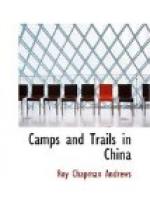At Yuang-chang we saw water buffaloes for the first time in Yuen-nan but found them to be in universal use farther to the south and west. The huge brutes are as docile as a kitten in the hands of the smallest native child but they do not like foreigners and discretion is the better part of valor where they are concerned.
Water buffaloes are only employed for work in the rice fields but Chinese cows are used as burden bearers in this part of the province. Such caravans travel much more slowly than do mule trains although the animals are not loaded as heavily. Two or three of the leading cows usually carry upon their backs large bells hung in wooden frameworks and the music is by no means unmelodious when heard at a distance. Marco Polo, the great Venetian traveler, refers to Yung-chang as “Vochang.” His account of a battle which was fought in its vicinity in the year 1272 between the King of Burma and Bengal and one of Kublai Khan’s generals is so interesting that I am quoting it below:
When the king of Mien [Burma] and Bangala [Bengal], in India, who was powerful in the number of his subjects, in extent of territory, and in wealth, heard that an army of Tartars had arrived at Vochang [Yung-chang] he took the resolution of advancing immediately to attack it, in order that by its destruction the grand khan should be deterred from again attempting to station a force upon the borders of his dominions. For this purpose he assembled a very large army, including a multitude of elephants (an animal with which his country abounds), upon whose backs were placed battlements or castles, of wood, capable of containing to the number of twelve or sixteen in each. With these, and a numerous army of horse and foot, he took the road to Vochang, where the grand khan’s army lay, and encamping at no great distance from it, intended to give his troops a few days of rest.
As soon as the approach of the king of Mien, with so great a force, was known to Nestardin, who commanded the troops of the grand khan, although a brave and able officer, he felt much alarmed, not having under his orders more than twelve thousand men (veterans, indeed, and valiant soldiers); whereas the enemy had sixty thousand, besides the elephants armed as has been described. He did not, however, betray any sign of apprehension, but descending into the plain of Vochang, took a position in which his flank was covered by a thick wood of large trees, whither, in case of a furious charge by the elephants, which his troops might not be able to sustain, they could retire, and from thence, in security, annoy them with their arrows....
Upon the king of Mien’s learning that the Tartars had descended into the plain, he immediately put his army in motion, took up his ground at the distance of about a mile from the enemy, and made a disposition of his force, placing the elephants in the front, and the cavalry and infantry,




